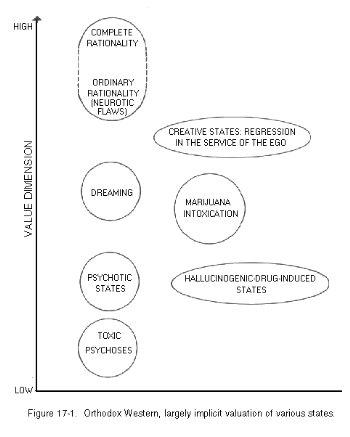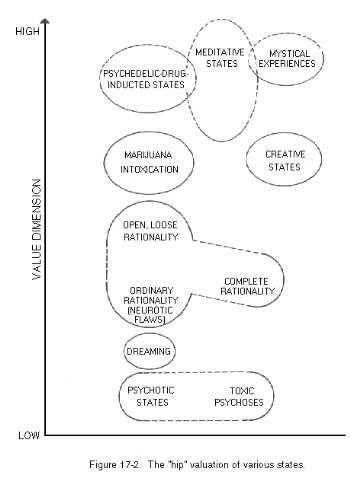


| HIGH VALUE DIMENSION LOW | 8th JHANA Neither perception nor nonperception, equanimity and one-pointedness. | FORMLESS STATES |
|---|---|---|
| 7th JHANA Awareness of no-thingness equanimity and one-pointedness. | ||
| 6th JHANA Objectless infinite consciousness, equanimity and one-pointedness. | ||
| 5th JHANA Consciousness of infinite space, equanimity and one-pointedness. | ||
| 4th JHANA Equanimity and one-pointedness, bliss, all feelings of bodily pleasure cease. | MATERIAL STATES | |
| 3rd JHANA Feelings of bliss, one-pointedness, and equanimity. Rapture ceases. | ||
| 2nd JHANA Feelings of rapture, bliss, one-pointedness. No thought of primary object of concentration. | ||
| 1st JHANA Hindering thoughts, sensory perception, and awareness of painful bodily states all cease. Initial and unbroken sustained attention to primary object of concentration, feelings of rapture, bliss, and one-pointedness | ||
| ACCESS STATE Hindering thoughts overcome, other thoughts remain. Awareness of sensory inputs and body states, primary object of concentration dominates thought. Feelings of rapture, happiness, equanimity. Initial and sustained thoughts of primary object. Flashes of light or bodily lightness. |
| HIGH VALUE DIMENSION LOW | NIRODH Total cessation of consciousness. |
|
|---|---|---|
| EFFORTLESS INSIGHT Contemplation is quick, effortless, indefatigable. Instantaneous knowledge of Anatta, Anicca, Dukkha. Cessation of pain, pervasive equanimity | ||
| REALIZATION Realizations of the dreadful, unsatisfactory, and wearisome nature of physical and mental phenomena, physical pain, arising of desire to escape these phenomena. Perception of vanishing of mind and objects, perception fast and flawless, disappearance of lights, rapture, etc. | ||
| PSEUDONIRVANA Clear perception of the arising and passing of each successive mind moment, accompanied by various phenomena such as brilliant light, rapturous feelings, tranquility, devotion, energy, happiness, strong mindfulness, equanimity toward objects of contemplation. Quick and clear perception, and attachment to these newly arisen states. | ||
| STAGE OF REFLECTIONS These processes seen as neither pleasant nor reliable. Experience of Dukkha, unsatisfactoriness. These processes are seen to arise and pass away at every moment of contemplation. Experience of Anicca. Impermanence. These dual processes are seen as devoid of self. Experience of Anatta, not-self, as distinct and separate processes. | ||
| MINDFULNESS Mindfulness of bodily function, physical sensations, mental states, or mind objects. | ||
| ACCESS CONCENTRATION Previous attainment of access. Concentration on path of concentration | BARE INSIGHT Achievement of ability to notice all phenomena of mind, to point where interfering thoughts do not seriously disturb practice. | |
| HIGH VALUE DIMENSION LOW | +3 Classical Satori. Fusion with Universal Mind, union with God, being one of the creators of energy from the void. Functioning in the Ma'h spiritual center above the head. |
|---|---|
| +6 Being a point source of consciousness, energy, light, and love. Astral travel and other PSI phenomena. Fusion with other entities in time. Functioning in the path mental center in the head. | |
| +12 Blissful, Christ-attuned state. Reception of Baraka (Divine Grace), cosmic love, cosmic energy, heightened bodily awareness. Highest function of bodily and planetside consciousness, being in love, being in a positive LSD energy state. Functioning in the Oth emotional center in the chest. | |
| +24 Professional Satori or basic Satori. All the needed programs are in the unconscious of the biocomputer, operating smoothly: The self is lost in pleasurable activities that one knows best and likes to do. Functioning in the Kath moving center in the lower belly. | |
| +/-48 The neutral biocomputer state. Absorption and transmission of new ideas, reception and transmission of new data and new programs, doing, teaching, and learning with maximum facility. Emotionally neutral. On the earth, excellent reality contact. | |
| -24 Neurotic states, negative states: Pain, guilt, fear, doing what one has to do but in a state of pain, guilt, fear. Slightly too much alcohol, small amount of opium, or first stages of lack of sleep. |
DRCNet Library | The Drugtext Libraries